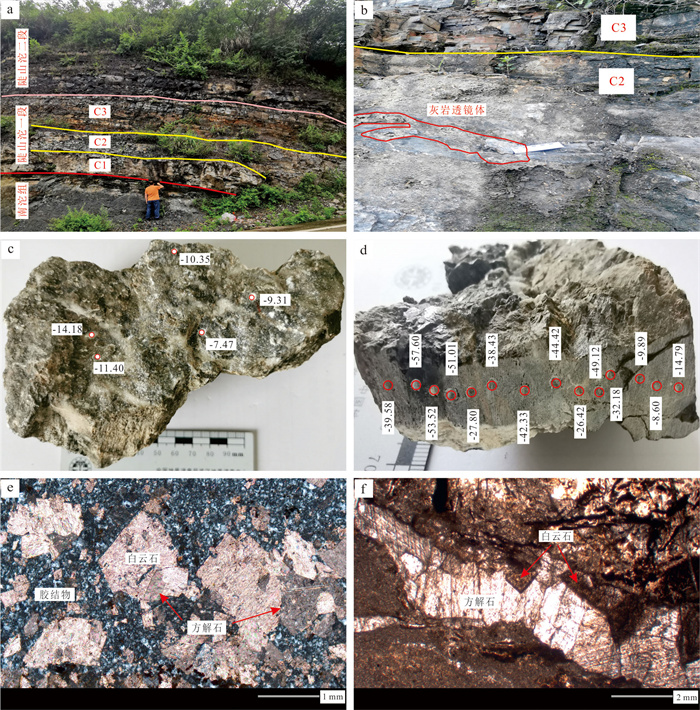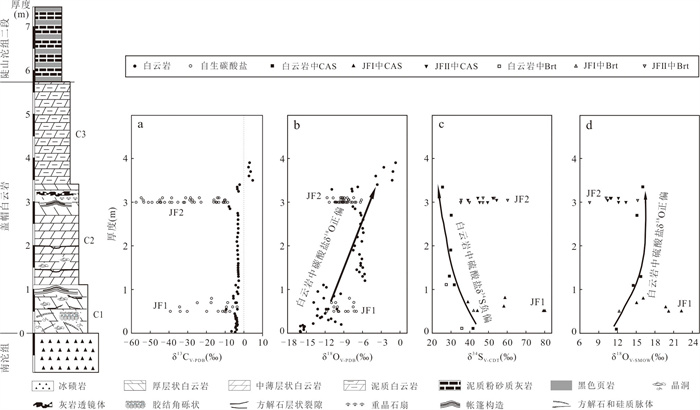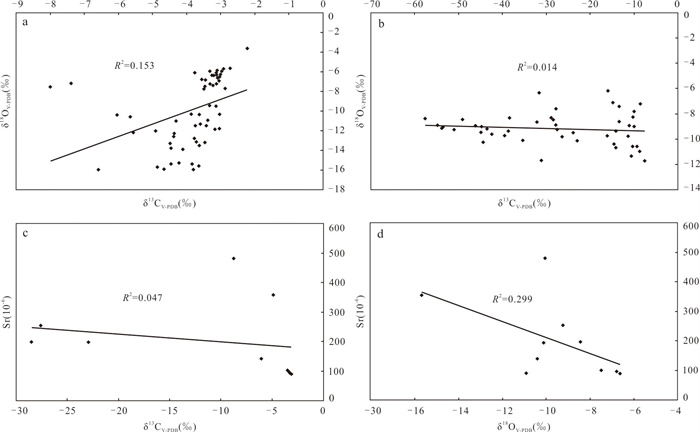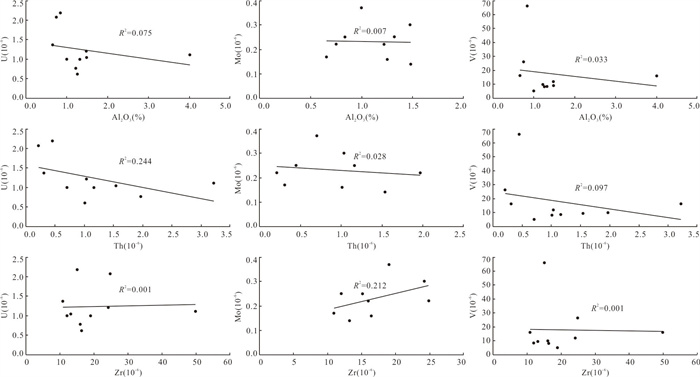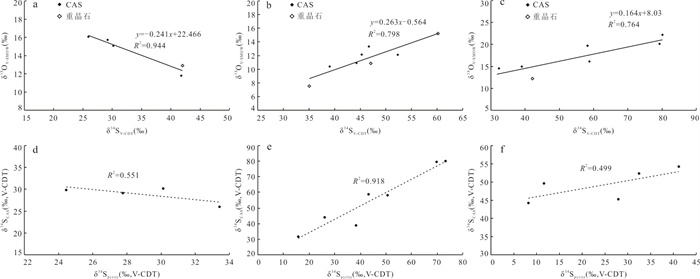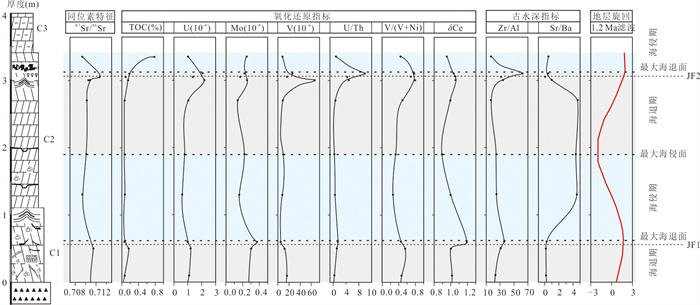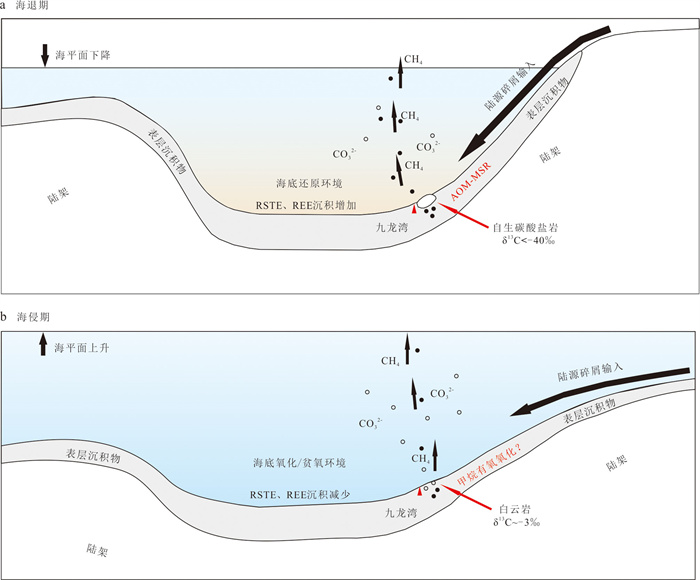Origin of Inorganic Carbon Isotope Excursions in Ediacaran Doushantuo Cap Dolostone at Jiulongwan Section in East Yangtze Gorges
-
摘要:
峡东地区埃迪卡拉纪陡山沱组盖帽白云岩中异常偏负的无机碳同位素(δ13CV‒PDB<‒40‰),是甲烷释放的关键地质证据,但其具体成因机制尚不明确.对九龙湾剖面陡山沱组盖帽白云岩中白云岩和自生碳酸盐岩的碳、氧、硫、锶同位素及元素地球化学进行对比研究.自生碳酸盐岩极低的无机碳同位素值,极大的硫酸盐和黄铁矿硫同位素变化范围,较低的δ18O(CAS,Brt)-δ34S(CAS,Brt)斜率,Δ33Spyrite-δ34Spyrite具有的负相关性,指示古海洋冷泉环境下AOM-MSR作用参与;氧化还原敏感元素显示自生碳酸盐岩(JF1和JF2)形成于缺氧环境,整个盖帽白云岩形成于氧化(/贫氧)‒缺氧‒氧化(/贫氧)‒缺氧‒氧化(/贫氧)环境转变;古水深指标指示在JF1和JF2阶段海平面分别下降;主、微量元素及锶同位素表明,JF1和JF2阶段陆源风化物质输入增加.九龙湾地区埃迪卡拉纪早期两次海退形成的海底缺氧环境和水化学条件改变,是形成极负无机碳同位素组成的重要原因.
Abstract:Extremely negative inorganic carbon isotope values (δ13CV‒PDB<‒40‰) from the Ediacaran Doushantuo cap dolostone in East Yangtze Gorges were taken as key evidence for a methane release event, but the origin of the cap dolostone remain contested. Here we investigated carbon, oxygen, sulfur, and strontium isotopes, and major and trace element compositions in both authigenic carbonates and dolostones from the Doushantuo cap dolostone at the Jiulongwan Section. Authigenic carbonates show extremely negative inorganic carbon isotope values, remarkably wide ranges of sulfur isotope values for sulfates and pyrites, a positive δ18O(CAS, Brt)-δ34S(CAS, Brt) correlation with a low slope, and a distinctly negative Δ33Spyrite-δ34Spyrite correlation, which indicates that the extremely 13C-depleted carbonates were deposited from seawater via anaerobic oxidation of methane coupled to microbial sulfate reduction (AOM-MSR) at paleo-marine cold seeps. Redox-sensitive elements reveal that the authigenic carbonates (JF1 and JF2) were deposited in an anoxic condition, while the whole cap dolostone was deposited in transitional conditions of suboxic-anoxic-suboxic-anoxic-suboxic. Paleodepth indicators imply that the sea level in the Jiulongwan area dropped during the JF1 and JF2 stages, respectively. Results of major and trace elements and strontium isotopes demonstrate that the input of terrigenous weathered materials increased during the JF1 and JF2 stages. In Early Ediacaran Epoch, two regressions in the Jiulongwan area resulted in an anoxic environment and altered hydrochemical conditions, which is an important origin for the extremely negative inorganic carbon isotopes observed in the cap dolostone in this area.
-
图 1 扬子板块埃迪卡拉纪沉积古地理(a、b)和黄陵背斜周缘地质简图(c)
a、b. 修改自Jiang et al.,2011;
魏昊明,2019 ;c. 修改自An et al.,2015Fig. 1. Paleogeographic map of Ediacaran depositional environment in the Yangtze Block (a, b) and sketch map around Huangling anticline (c)
图 2 九龙湾盖帽白云岩地层、岩石手标本和镜下照片
a. 九龙湾盖帽白云岩(C1+C2+C3)野外露头,南沱组冰碛砾岩与盖帽白云岩呈整合接触关系,照片中人身高1.75 m;b. 盖帽白云岩C2中顺层产出灰岩透镜体;c. HNYD06白云岩手标本,数据为微钻取样后测得的方解石胶结物无机δ13CV‒PDB值(‰);d. HNYD27-2灰岩透镜体手标本,数据为微钻取样后测得的无机δ13CV‒PDB值(‰);e.白云岩中方解石胶结物显微照片(正交偏光);f. 灰岩透镜体中方解石脉显微照片(单偏光)
Fig. 2. Stratum, specimens and microscopic photographs of the cap dolostone at the Jiulongwan Section
图 3 九龙湾盖帽白云岩剖面及碳、氧、硫同位素组成变化
a. 碳酸盐无机碳同位素组成;b. 碳酸盐氧同位素组成;c. 硫酸盐(CAS和Brt)硫同位素组成;d. 硫酸盐(CAS和Brt)氧同位素组成. 剖面柱状图据Wang et al.,2008修改
Fig. 3. Stratigraphic column and carbon, oxygen and sulfur isotope profiles of the cap dolostone at Jiulongwan Section
表 1 峡东九龙湾剖面盖帽白云岩硫、氧、锶同位素组成
Table 1. Sulfur, oxygen, and strontium isotopes of the cap dolostone at Jiulongwan Section
样品编号 岩性/矿物 δ34SCAS
(V-CDT, ‰)δ18OCAS
(V-SMOW, ‰)δ34SBrt
(V-CDT, ‰)δ18OBrt
(V-SMOW, ‰)δ34SPy
(V-CDT, ‰)$ \frac{{}^{87}\mathrm{S}\mathrm{r}}{{}^{86}\mathrm{S}\mathrm{r}}\left(1\sigma \right) $ HNYD01 白云岩 41.79 11.80 35.77 ‒ ‒ ‒ HNYD03 白云岩 39.52 ‒ 42.00 12.90 ‒ ‒ HNYD06 方解石胶结物 44.09 ‒ 42.10 12.24 26.07 0.711 50(1) HNYD07 方解石胶结物 31.73 14.54 27.44 ‒ 15.74 ‒ HNYD11 白云岩 29.17 15.73 ‒ ‒ 27.76 0.709 34(2) HNYD16-17 白云岩 29.85 ‒ ‒ ‒ 24.45 0.710 19(1) HNYD25 白云岩 30.16 15.11 ‒ ‒ 30.12 0.710 23(1) HNYD27-1 灰岩透镜体 46.72 13.34 39.83 ‒ ‒ ‒ HNYD27-2 灰岩透镜体 45.26 12.16 35.10 7.53 27.99 0.710 77(1) HNYD27-3 灰岩透镜体 49.54 ‒ 46.90 ‒ 11.62 0.710 53(1) HNYD28-1 灰岩透镜体 39.01 10.42 35.41 ‒ ‒ ‒ HNYD28-2 灰岩透镜体 54.31 ‒ 60.18 15.21 41.15 0.712 70(3) HNYD29-1 灰岩透镜体 52.33 12.12 52.96 ‒ 32.51 ‒ HNYD29-2 灰岩透镜体 44.27 10.91 47.03 10.87 8.18 ‒ HNYD31-32 白云岩 25.93 16.06 ‒ ‒ 33.41 0.709 35(1) JLW-C1-1 亮晶方解石脉和胶结物 79.3 20.1 ‒ ‒ 69.8 ‒ JLW-C1-1-2 亮晶方解石脉和胶结物 80.1 22.2 ‒ ‒ 73.4 ‒ JLW-C1-3 亮晶方解石脉和胶结物 58.2 19.7 ‒ ‒ 50.6 ‒ JLW-C1-4 亮晶方解石脉和胶结物 39.0 15.0 ‒ ‒ 38.4 ‒ JLW-C1-6 亮晶方解石脉和胶结物 58.8 16.1 ‒ ‒ 43.2 ‒ 注:JLW开头样品引自 Peng et al.(2022) ,其他数据为本文测定;“‒”表示该项分析未测或未测出.表 2 九龙湾剖面盖帽白云岩主、微量元素和有机碳含量及相关计算结果
Table 2. Results of major and trace element and total organic carbon contents of the cap dolostone at Jiulongwan Section
样品编号 岩性 主量元素(%) 微量元素(10-6) TOC
(%)U/Th Mn/Sr Zr/Al Sr/Ba V/(V+Ni) Al2O3 CaO MgO K2O MnO Fe2O3 U Mo V Th Ni Zr Sr Ba HNYD01 白云岩 4.01 35.68 2.28 0.61 0.52 3.50 1.11 1.62 16.20 3.22 18.70 49.80 357.0 2 000.0 0.072 0.34 11.2 23.5 0.18 0.46 HNYD06 自生碳酸盐岩 1.56 44.88 4.71 0.14 0.61 0.96 1.21 0.30 15.44 1.04 12.51 24.20 481.0 3 080.0 0.133 1.16 9.8 30.9 0.16 0.55 HNYD07 自生碳酸盐岩 1.00 32.41 13.22 0.24 0.33 1.03 1.00 0.37 10.31 0.70 12.42 19.00 141.0 525.0 0.044 1.43 18.2 36.0 0.27 0.45 HNYD11 白云岩 1.25 30.33 16.55 0.26 0.16 0.62 0.61 0.16 8.26 1.01 23.67 16.40 90.7 20.0 0.075 0.60 13.8 24.8 4.54 0.26 HNYD16-17 白云岩 1.22 31.43 16.71 0.26 0.27 0.76 0.77 0.22 9.92 1.97 20.91 16.00 101.0 25.4 0.076 0.39 20.8 24.8 3.98 0.32 HNYD25 白云岩 1.48 31.13 16.93 0.33 0.28 0.75 1.04 0.14 9.34 1.54 9.75 13.20 93.4 20.0 0.074 0.68 23.3 16.8 4.67 0.49 HNYD27-2 自生碳酸盐岩 0.84 44.54 1.89 0.21 0.93 1.05 2.18 0.25 65.90 0.45 17.04 15.10 197.0 209.0 0.126 4.84 36.5 34.1 0.94 0.79 HNYD28-2 自生碳酸盐岩 0.66 47.89 2.87 0.17 1.09 0.88 1.36 0.17 16.20 0.31 7.17 10.90 254.0 4 640.0 0.086 4.39 33.2 31.4 0.05 0.69 HNYD29-1 自生碳酸盐岩 0.75 43.71 3.34 0.20 1.13 1.10 2.07 0.22 26.20 0.21 7.68 24.80 198.0 396.0 0.182 9.86 44.2 62.4 0.50 0.77 HNYD31-32 白云岩 1.32 30.28 18.52 0.33 0.27 0.91 1.00 0.25 8.54 1.16 10.87 12.00 98.6 195.0 0.779 0.86 21.5 17.2 0.51 0.44 表 3 九龙湾剖面盖帽白云岩稀土元素含量(10-6)及相关计算结果
Table 3. Results of rare earth element contents (10-6) of the cap dolostone at Jiulongwan Section
样品编号 岩性 La Ce Pr Nd Sm Eu Gd Tb Dy Y Ho Er Tm Yb Lu Y/Ho ΣREE+Y δCe δEu HNYD01 白云岩 16.58 38.45 4.54 19.31 3.95 1.07 3.42 0.50 2.64 15.59 0.46 1.06 0.15 0.90 0.13 33.54 108.77 1.02 1.47 HNYD06 自生碳酸盐岩 2.02 4.15 0.45 1.88 0.35 0.08 0.36 0.05 0.29 2.02 0.05 0.13 0.02 0.14 0.02 38.80 12.01 1.00 1.31 HNYD11 白云岩 2.19 4.67 0.53 2.23 0.48 0.11 0.41 0.07 0.39 3.27 0.08 0.22 0.03 0.23 0.03 41.38 14.95 1.00 1.17 HNYD16-17 白云岩 2.48 4.78 0.61 2.53 0.54 0.14 0.52 0.10 0.60 5.70 0.13 0.36 0.06 0.40 0.07 44.50 19.01 0.89 1.40 HNYD25 白云岩 1.76 3.64 0.40 1.81 0.37 0.09 0.36 0.06 0.37 2.89 0.08 0.20 0.03 0.24 0.03 34.51 12.35 0.99 1.24 HNYD27-2 自生碳酸盐岩 8.95 17.17 1.52 6.47 1.24 0.34 1.44 0.23 1.55 16.73 0.37 1.00 0.15 0.81 0.11 45.04 58.08 1.06 1.26 HNYD27-3 自生碳酸盐岩 14.34 31.59 3.32 14.50 3.02 0.62 3.36 0.61 4.44 38.22 0.99 3.00 0.49 3.15 0.42 38.46 122.07 1.05 0.92 HNYD28-1 自生碳酸盐岩 12.72 32.20 3.07 13.53 2.86 0.61 3.01 0.56 3.85 31.80 0.85 2.40 0.40 2.45 0.34 37.22 110.65 1.19 0.97 HNYD29-1 自生碳酸盐岩 5.66 10.26 0.88 3.61 0.68 0.22 0.77 0.12 0.78 7.26 0.18 0.47 0.07 0.42 0.06 40.47 31.45 1.03 1.61 HNYD31-32 白云岩 2.00 3.98 0.46 1.91 0.44 0.10 0.39 0.06 0.45 3.11 0.09 0.24 0.04 0.23 0.03 36.18 13.53 0.95 1.29 注:δCe=2CeN/(LaN+PrN),δEu=2EuN/(SmN+GdN),下标N代表稀土元素经澳大利亚后太古代页岩(PAAS)标准化之后的数值. -
Ader, M., Macouin, M., Trindade, R. I. F., et al., 2009. A Multilayered Water Column in the Ediacaran Yangtze Platform? Insights from Carbonate and Organic Matter Paired δ13C. Earth and Planetary Science Letters, 288(1-2): 213-227. https://doi.org/10.1016/j.epsl.2009.09.024 Algeo, T. J., Maynard, J. B., 2008. Trace-Metal Covariation as a Guide to Water-Mass Conditions in Ancient Anoxic Marine Environments. Geosphere, 4(5): 872-887. https://doi.org/10.1130/GES00174.1 An, Z. H., Jiang, G. Q., Tong, J. N., et al., 2015. Stratigraphic Position of the Ediacaran Miaohe Biota and Its Constrains on the Age of the Upper Doushantuo δ13C Anomaly in the Yangtze Gorges Area, South China. Precambrian Research, 271: 243-253. https://doi.org/10.1016/j.precamres.2015.10.007 Antler, G., Turchyn, A. V., Herut, B., et al., 2014. Sulfur and Oxygen Isotope Tracing of Sulfate Driven Anaerobic Methane Oxidation in Estuarine Sediments. Estuarine, Coastal and Shelf Science, 142: 4-11. https://doi.org/10.1016/j.ecss.2014.03.001 Banner, J. L., Hanson, G. N., 1990. Calculation of Simultaneous Isotopic and Trace Element Variations during Water-Rock Interaction with Applications to Carbonate Diagenesis. Geochimica et Cosmochimica Acta, 54(11): 3123-3137. https://doi.org/10.1016/0016-7037(90)90128-8 Bao, H. M., 2006. Purifying Barite for Oxygen Isotope Measurement by Dissolution and Reprecipitation in a Chelating Solution. Analytical Chemistry, 78(1): 304-309. https://doi.org/10.1021/ac051568z Bristow, T. F., Bonifacie, M., Derkowski, A., et al., 2011. A Hydrothermal Origin for Isotopically Anomalous Cap Dolostone Cements from South China. Nature, 474(7349): 68-71. https://doi.org/10.1038/nature10096 Cai, C. F., Liu, D. W., Hu, Y. J., et al., 2023. Interlinked Marine Cycles of Methane, Manganese, and Sulfate in the Post-Marinoan Doushantuo Cap Dolostone. Geochimica et Cosmochimica Acta, 346: 245-258. https://doi.org/10.1016/j.gca.2023.02.014 Canfield, D. E., Raiswell, R., Westrich, J. T., et al., 1986. The Use of Chromium Reduction in the Analysis of Reduced Inorganic Sulfur in Sediments and Shales. Chemical Geology, 54(1-2): 149-155. https://doi.org/10.1016/0009-2541(86)90078-1 Frimmel, H. E., 2009. Trace Element Distribution in Neoproterozoic Carbonates as Palaeoenvironmental Indicator. Chemical Geology, 258(3-4): 338-353. https://doi.org/10.1016/j.chemgeo.2008.10.033 Feng, D., Gong, S. G., 2019. Progress on the Biogeochemical Process of Sulfur and Its Geological Record at Submarine Cold Seeps. Bulletin of Mineralogy, Petrology and Geochemistry, 38(6): 1047-1056, 1046 (in Chinese with English abstract). Feng, D., Peng, Y. B., Bao, H. M., et al., 2016. A Carbonate-Based Proxy for Sulfate-Driven Anaerobic Oxidation of Methane. Geology, 44(12): 999-1002. https://doi.org/10.1130/G38233.1 Feng, D., Roberts, H. H., 2011. Geochemical Characteristics of the Barite Deposits at Cold Seeps from the Northern Gulf of Mexico Continental Slope. Earth and Planetary Science Letters, 309(1-2): 89-99. https://doi.org/10.1016/j.epsl.2011.06.017 Gong, S. G., Peng, Y. B., Bao, H. M., et al., 2018. Triple Sulfur Isotope Relationships during Sulfate-Driven Anaerobic Oxidation of Methane. Earth and Planetary Science Letters, 504: 13-20. https://doi.org/10.1016/j.epsl.2018.09.036 Guan, C. G., Wang, W., Zhou, C. M., 2024. Revisiting the Carbonate Carbon Isotopic Composition of the Lowermost Doushantuo Formation in Yichang, Hubei Province: Implications for Searching the Original Seawater Carbon Isotopic Signal. Acta Geologica Sinica, 98(3): 712-724 (in Chinese with English abstract). Hatch, J. R., Leventhal, J. S., 1992. Relationship between Inferred Redox Potential of the Depositional Environment and Geochemistry of the Upper Pennsylvanian (Missourian) Stark Shale Member of the Dennis Limestone, Wabaunsee County, Kansas, U. S. A. . Chemical Geology, 99(1-3): 65-82. https://doi.org/10.1016/0009-2541(92)90031-Y Higgins, J. A., Blättler, C. L., Lundstrom, E. A., et al., 2018. Mineralogy, Early Marine Diagenesis, and the Chemistry of Shallow-Water Carbonate Sediments. Geochimica et Cosmochimica Acta, 220: 512-534. https://doi.org/10.1016/j.gca.2017.09.046 Hoffman, P. F., Kaufman, A. J., Halverson, G. P., et al., 1998. A Neoproterozoic Snowball Earth. Science, 281(5381): 1342-1346. https://doi.org/10.1126/science.281.5381.1342 Hoffman, P. F., Schrag, D. P., 2002. The Snowball Earth Hypothesis: Testing the Limits of Global Change. Terra Nova, 14(3): 129-155. https://doi.org/10.1046/j.1365-3121.2002.00408.x Horacek, M., Brandner, R., Abart, R., 2007. Carbon Isotope Record of the P/T Boundary and the Lower Triassic in the Southern Alps: Evidence for Rapid Changes in Storage of Organic Carbon. Palaeogeography, Palaeoclimatology, Palaeoecology, 252(1-2): 347-354. https://doi.org/10.1016/j.palaeo.2006.11.049 Jiang, G. Q., Kennedy, M. J., Christie-Blick, N., 2003. Stable Isotopic Evidence for Methane Seeps in Neoproterozoic Postglacial Cap Carbonates. Nature, 426(6968): 822-826. https://doi.org/10.1038/nature02201 Jiang, G. Q., Shi, X. Y., Zhang, S. H., et al., 2011. Stratigraphy and Paleogeography of the Ediacaran Doushantuo Formation (ca. 635-551 Ma) in South China. Gondwana Research, 19(4): 831-849. https://doi.org/10.1016/j.gr.2011.01.006 Jiang, G. Q., Zhang, S. H., Shi, X. Y., et al., 2008. Chemocline Instability and Isotope Variations of the Ediacaran Doushantuo Basin in South China. Science China Earth Sciences, 51(11): 1560-1569. https://doi.org/10.1007/s11430-008-0116-2 Li, C., Hardisty, D. S., Luo, G., et al., 2017. Uncovering the Spatial Heterogeneity of Ediacaran Carbon Cycling. Geobiology, 15(2): 211-224. https://doi.org/10.1111/gbi.12222 Li, D., Ling, H. F., Jiang, S. Y., et al., 2009. New Carbon Isotope Stratigraphy of the Ediacaran-Cambrian Boundary Interval from SW China: Implications for Global Correlation. Geological Magazine, 146(4): 465-484. https://doi.org/10.1017/S0016756809006268 Li, W. P., 2017. Geochemistry of Sedimentary Carbonates from the Late Ediacaran to the Early Cambrian in the Lower Yangtze Region of South China (Dissertation). University of Science and Technology of China, Hefei (in Chinese with English abstract). Lin, Z. J., Wang, Q. X., Feng, D., et al., 2011. Post-Depositional Origin of Highly 13C-Depleted Carbonate in the Doushantuo Cap Dolostone in South China: Insights from Petrography and Stable Carbon Isotopes. Sedimentary Geology, 242(1-4): 71-79. https://doi.org/10.1016/j.sedgeo.2011.10.009 Lin, Z. Y., Sun, X. M., Peckmann, J., et al., 2016. How Sulfate-Driven Anaerobic Oxidation of Methane Affects the Sulfur Isotopic Composition of Pyrite: A SIMS Study from the South China Sea. Chemical Geology, 440: 26-41. https://doi.org/10.1016/j.chemgeo.2016.07.007 Liu, C., Wang, Z. R., Raub, T. D., et al., 2014. Neoproterozoic Cap-Dolostone Deposition in Stratified Glacial Meltwater Plume. Earth and Planetary Science Letters, 404: 22-32. https://doi.org/10.1016/j.epsl.2014.06.039 Lu, M., Zhu, M. Y., Zhang, J. M., et al., 2013. The DOUNCE Event at the Top of the Ediacaran Doushantuo Formation, South China: Broad Stratigraphic Occurrence and Non-Diagenetic Origin. Precambrian Research, 225: 86-109. https://doi.org/10.1016/j.precamres.2011.10.018 Montañez, I. P., Osleger, D. A., Mack, L. E., et al., 2000. Evolution of the Sr and C Isotope Composition of Cambrian Oceans. GSA Today, 10(5): 1-7. Peng, Y. B., Bao, H. M., Jiang, G. Q., et al., 2022. A Transient Peak in Marine Sulfate after the 635 Ma Snowball Earth. Proceedings of the National Academy of Sciences of the United States of America, 119(19): e2117341119. https://doi.org/10.1073/pnas.2117341119 Porter, S. M., Knoll, A. H., Affaton, P., 2004. Chemostratigraphy of Neoproterozoic Cap Carbonates from the Volta Basin, West Africa. Precambrian Research, 130(1-4): 99-112. https://doi.org/10.1016/j.precamres.2003.10.015 Rimmer, S. M., 2004. Geochemical Paleoredox Indicators in Devonian-Mississippian Black Shales, Central Appalachian Basin (USA). Chemical Geology, 206(3-4): 373-391. https://doi.org/10.1016/j.chemgeo.2003.12.029 Sansjofre, P., Ader, M., Trindade, R. I. F., et al., 2011. A Carbon Isotope Challenge to the Snowball Earth. Nature, 478(7367): 93-96. https://doi.org/10.1038/nature10499 Shen, H. J., Gu, S. Y., Zhao, S. F., et al., 2020. The Sedimentary Geochemical Records of Ocean Environment during the Nantuo (Marinoan) Glaciation in South China-Carbon and Oxygen Isotopes and Trace Element Compositions of Dolostone in Nantuo Formation, Nanhuan System, in Eastern Guizhou. Geological Review, 66(1): 214-228 (in Chinese with English abstract). Shi, H. Y., Sun, Y. P., Ouyang, Q., et al., 2023. U-Pb Age of Highly 13C-Depleted Calcite from the Basal Ediacaran Cap Carbonate in Yichang, Hubei Province. Journal of Stratigraphy, 47(1): 1-16 (in Chinese with English abstract). Sui, Y., 2019. Cyclostratigraphic Analysis of the Ediacaran Doushantuo Formation, South China (Dissertation). China University of Geosciences, Wuhan (in Chinese with English abstract). Tribovillard, N., Algeo, T. J., Lyons, T., et al., 2006. Trace Metals as Paleoredox and Paleoproductivity Proxies: An Update. Chemical Geology, 232(1-2): 12-32. https://doi.org/10.1016/j.chemgeo.2006.02.012 Veizer, J., 1983. Chemical Diagenesis of Carbonates: Theory and Application of Trace Element Technique. In: Arthur, M. A., Anderson, T. F., Kaplan, I. R., et al., eds., Stable Isotopes in Sedimentary Geology. SEPM, Tulsa. Veizer, J., Ala, D., Azmy, K., et al., 1999. 87Sr/86Sr, δ13C and δ18O Evolution of Phanerozoic Seawater. Chemical Geology, 161(1-3): 59-88. https://doi.org/10.1016/S0009-2541(99)00081-9 Wang, J. S., Jiang, G. Q., Xiao, S. H., et al., 2008. Carbon Isotope Evidence for Widespread Methane Seeps in the ca. 635 Ma Doushantuo Cap Carbonate in South China. Geology, 36(5): 347-350. https://doi.org/10.1130/g24513a.1 Wang, J. S., Wang, Z., Hu, J., et al., 2012. Multiple Proxies Indicating Methane Seepage during the Neoproterozoic Cap Carbonate in South China. Earth Science, 37(S2): 14-22 (in Chinese with English abstract). Wang, Z., 2017. The Diagenesis of Early and Middle Ediacaran Carbonate Sediments in Western Hubei and the Paleoenvironmental Implications of the Doushantuo Glendonite (Dissertation). China University of Geosciences, Wuhan (in Chinese with English abstract). Webb, G. E., Kamber, B. S., 2000. Rare Earth Elements in Holocene Reefal Microbialites: A New Shallow Seawater Proxy. Geochimica et Cosmochimica Acta, 64(9): 1557-1565. https://doi.org/10.1016/S0016-7037(99)00400-7 Wei, G. Y., 2019. Evolution of Marine Environment from the Late Neoproterozoic to Early Paleozoic (Dissertation). Nanjing University, Nanjing (in Chinese with English abstract). Wei, H. M., 2019. The Evolution of Shallow Ocean Redox on Edicaran Yangtze Platform (Dissertation). China University of Geosciences, Beijing (in Chinese with English abstract). Zhou, C. M., Bao, H. M., Peng, Y. B., et al., 2010. Timing the Deposition of 17O-Depleted Barite at the Aftermath of Nantuo Glacial Meltdown in South China. Geology, 38(10): 903-906. https://doi.org/10.1130/G31224.1 Zhou, C. M., Xie, G. W., McFadden, K., et al., 2007. The Diversification and Extinction of Doushantuo-Pertatataka Acritarchs in South China: Causes and Biostratigraphic Significance. Geological Journal, 42(3-4): 229-262. https://doi.org/10.1002/gj.1062 Zhu, M. Y., Zhang, J. M., Yang, A. H., 2007. Integrated Ediacaran (Sinian) Chronostratigraphy of South China. Palaeogeography, Palaeoclimatology, Palaeoecology, 254(1-2): 7-61. https://doi.org/10.1016/j.palaeo.2007.03.025 冯东, 宫尚桂, 2019. 海底冷泉系统硫的生物地球化学过程及其沉积记录研究进展. 矿物岩石地球化学通报, 38(6): 1047-1056, 1046. 关成国, 王伟, 周传明, 2024. 湖北宜昌埃迪卡拉系陡山沱组下部无机碳同位素再研究: 探寻碳酸盐岩碳同位素组成的原始海水信号. 地质学报, 98(3): 712-724. 李伟平, 2017. 下扬子埃迪卡拉纪晚期和寒武纪早期沉积碳酸盐岩地球化学研究(博士学位论文). 合肥: 中国科学技术大学. 沈洪娟, 顾尚义, 赵思凡, 等, 2020. 华南南华纪南沱冰期海洋环境的沉积地球化学记录——来自黔东部南华系南沱组白云岩碳氧同位素和微量元素的证据. 地质论评, 66(1): 214-228. 史红毅, 孙云鹏, 欧阳晴, 等, 2023. 湖北宜昌埃迪卡拉系陡山沱组底部盖帽碳酸盐岩中具极负碳同位素值方解石的U-Pb年龄. 地层学杂志, 47(1): 1-16. 睢瑜, 2019. 华南地区埃迪卡拉纪陡山沱组旋回地层学研究(博士学位论文). 武汉: 中国地质大学. 王家生, 王舟, 胡军, 等, 2012. 华南新元古代"盖帽"碳酸盐岩中甲烷渗漏事件的综合识别特征. 地球科学, 37(S2): 14-22. https://cstj.cqvip.com/Qikan/Article/Detail?id=1003445673 王舟, 2017. 鄂西埃迪卡拉纪早中期碳酸盐岩地层成岩作用及其六水碳钙石假晶的古环境意义(博士学位论文). 武汉: 中国地质大学. 魏广祎, 2019. 新元古代晚期到古生代早期古海洋地球化学演变(博士学位论文). 南京: 南京大学. 魏昊明, 2019. 埃迪卡拉纪扬子地台浅海氧化还原状态的时空演变(博士学位论文). 北京: 中国地质大学. -









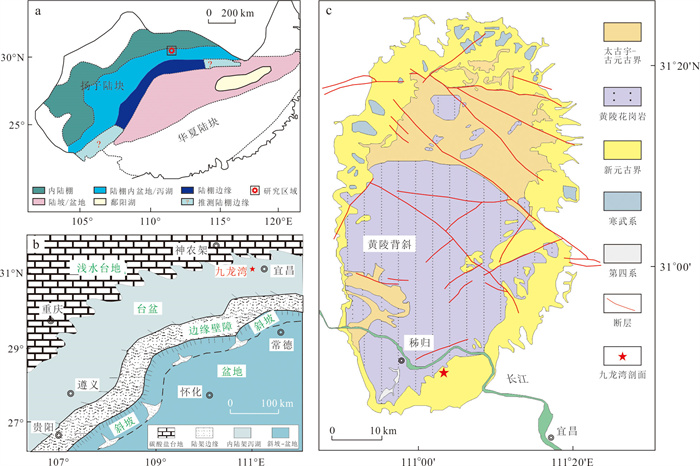
 下载:
下载:
